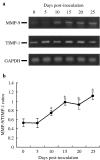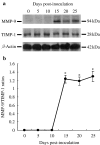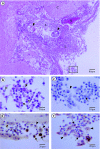Upregulation of MMP-9/TIMP-1 enzymatic system in eosinophilic meningitis caused by Angiostrongylus cantonensis
- PMID: 15810979
- PMCID: PMC2517405
- DOI: 10.1111/j.0959-9673.2005.00413.x
Upregulation of MMP-9/TIMP-1 enzymatic system in eosinophilic meningitis caused by Angiostrongylus cantonensis
Abstract
Proteolysis depends on the balance between the proteases and their inhibitors. Matrix metalloproteinase-9 (MMP-9) and its specific inhibitors, tissue inhibitors of metalloproteinases (TIMP), contribute to eosinophilic inflammatory reaction in the subarachnoid space of the Angiostrongylus cantonensis-infected mice. The expression of MMP-9 in cerebrospinal fluid (CSF) was significantly increased in mice with eosinophilic meningitis, compared to that in uninfected ones. However, the TIMP-1 levels were unchanged and remained at basal levels at all time points, even in uninfected mice. Elevated MMP-9 mRNA expression coincided with protein levels and proteolytic activity, as demonstrated by means of positive immunoreactivity and gelatin zymography. CSF protein contents correlated significantly with MMP-9 intensity and CSF eosinophilia. In addition, immunohistochemistry demonstrated MMP-9 and TIMP-1 localization in eosinophils and macrophages. When the specific MMP inhibitor, GM6001, was added, MMP-9 enzyme activity was reduced by 45.4%. The percentage of eosinophil increased significantly upon the establishment of infection, but subsided upon inhibition. These results show that MMP-9/TIMP-1 imbalance in angiostrongyliasis may be associated with eosinophilic meningitis.
Figures






Similar articles
-
Association of matrix metalloproteinase-9 and tissue inhibitors of metalloproteinase-4 in cerebrospinal fluid with blood-brain barrier dysfunction in patients with eosinophilic meningitis caused by Angiostrongylus cantonensis.Am J Trop Med Hyg. 2008 Jan;78(1):20-7. Am J Trop Med Hyg. 2008. PMID: 18187780
-
Elevation of plasminogen activators in cerebrospinal fluid of mice with eosinophilic meningitis caused by Angiostrongylus cantonensis.Int J Parasitol. 2004 Nov;34(12):1355-64. doi: 10.1016/j.ijpara.2004.08.010. Int J Parasitol. 2004. PMID: 15542096
-
Association of matrix metalloproteinase-9 in eosinophilic meningitis of BALB/c mice caused by Angiostrongylus cantonensis.Parasitol Res. 2004 Nov;94(5):321-8. doi: 10.1007/s00436-004-1196-3. Epub 2004 Sep 21. Parasitol Res. 2004. PMID: 15449178
-
Severe eosinophilic meningitis owing to Angiostrongylus cantonensis in young Jamaican children: case report and literature review.Paediatr Int Child Health. 2014 May;34(2):148-52. doi: 10.1179/2046905513Y.0000000106. Epub 2013 Dec 6. Paediatr Int Child Health. 2014. PMID: 24199629 Review.
-
The role of eosinophils in angiostrongyliasis: multiple roles for a versatile cell?Hawaii J Med Public Health. 2013 Jun;72(6 Suppl 2):49-51. Hawaii J Med Public Health. 2013. PMID: 23901384 Free PMC article. Review.
Cited by
-
The opposite roles of PAS-5 and Galectin-1 in immune response during the early infection of Angiostrongylus cantonensis.Parasit Vectors. 2018 May 29;11(1):318. doi: 10.1186/s13071-018-2894-5. Parasit Vectors. 2018. PMID: 29843794 Free PMC article.
-
The significance of matrix metalloproteinases in parasitic infections involving the central nervous system.Pathogens. 2013 Feb 19;2(1):105-29. doi: 10.3390/pathogens2010105. Pathogens. 2013. PMID: 25436884 Free PMC article. Review.
-
Granulocytes in helminth infection -- who is calling the shots?Curr Med Chem. 2012;19(10):1567-86. doi: 10.2174/092986712799828337. Curr Med Chem. 2012. PMID: 22360486 Free PMC article. Review.
-
Differential regulation of matrix-metalloproteinases and their tissue inhibitors in patients with aneurysmal subarachnoid hemorrhage.PLoS One. 2013;8(3):e59952. doi: 10.1371/journal.pone.0059952. Epub 2013 Mar 28. PLoS One. 2013. PMID: 23555845 Free PMC article.
References
-
- Alicata JE, Jindrak K. Springfield, IL: Thomas; 1970. Angiostrongylosis in the Pacific and Southeast Asia.
-
- Ash LR. Diagnostic morphology of the third-stage larvae of Angiostrongylus cantonensis, Angiostrongylus vasorum, Aelurostrongylus abstrusus and Anafilaroides rostratus (Nematoda: Metastrongyloidea) J Parasitol. 1970;56:249–253. - PubMed
-
- Bottomley KM, Johnson WH, Walter DS. Matrix metallo-proteinase inhibitors in arthritis. J Enzyme Inhib. 1998;13:79–101. - PubMed
-
- Damjanov I, McCue PA, Chansky M. Nervous system. In: Velker J, editor. Histopathology a Color Atlas and Textbook. New York, USA: Williams & Wilkins; 1996. pp. 459–489.
Publication types
MeSH terms
Substances
LinkOut - more resources
Full Text Sources
Medical
Research Materials
Miscellaneous

